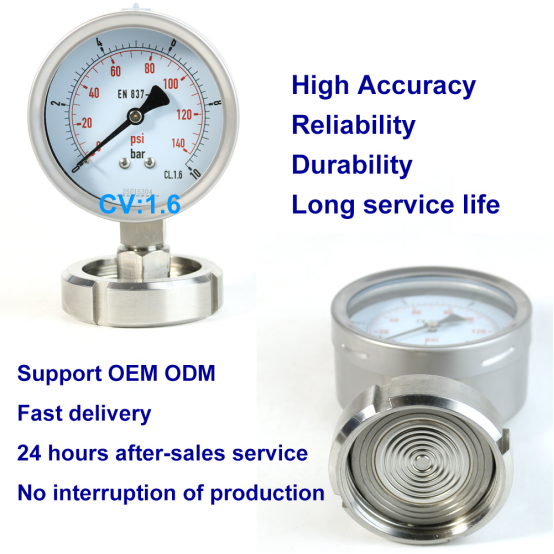Selecting the right stainless steel pressure gauge for your use requires comprehensive consideration of a number of factors, including the measurement environment, media characteristics, accuracy requirements, installation methods and so on. The following are the key selection points:

1. Determine the measurement range and range
Stable pressure: the maximum working pressure does not exceed 2/3 of the range.
Pulsating pressure (such as hydraulic systems): the maximum working pressure does not exceed 1/2 of the range.
High pressure measurement: max. working pressure not exceeding 3/5 of the measuring range.
Minimum pressure: not less than 1/3 of the measuring range to ensure measurement accuracy.
2. Selecting an Accuracy Level
For high accuracy requirements (e.g., aerospace, laboratory): select Class 1.0 or Class 1.6.
General industrial applications (e.g., water supply and drainage, boilers): Class 2.5 is sufficient.

3. Consider media characteristics
Corrosive media (e.g. acids and alkalis, chemical fluids): choose 316 or 316L stainless steel, or even titanium or monel alloys.
Viscous or easily crystallised media: choose diaphragm gauges to prevent clogging.
High-temperature media: stainless steel movement can withstand +200°C, but the liquid-filled shock-resistant type can only support +100°C, and condensation bends are required for ultra-high temperatures. 4.
4. Dial size and mounting method
Small space installation (such as equipment panel): 50mm or 60mm dial.
Remote observation (e.g. pipeline monitoring): 100mm or 150mm dial.
Mounting method:
Radial connection (bottom mounting).
Axial connection (back mounting).
Flange or clamp mounting (special requirements). 5.

5. Vibration Resistance and Protection Requirements
High vibration environments (e.g., machine shop, marine): Select a liquid-filled, vibration-resistant gauge to minimise pointer jitter.
Wet or corrosive environments: Ensure IP65 or higher protection against water vapour.
6. Thread and Connection Standards
Common thread sizes: M14 x 1.5, G1/4, NPT1/2, etc., need to match the equipment interface.
7. Maintenance and Calibration
Check regularly (at least every 3 months) to ensure the accuracy of the measurement.
When installing, avoid screwing the case by hand and use a spanner to prevent damage.
To summarise
When selecting a stainless steel pressure gauge, it is important to take into account the measuring range, accuracy, media, environment, and mounting method to ensure stability, durability, and measurement accuracy. For special conditions (e.g. extreme temperatures, strong corrosion), diaphragm seals or customised models can be considered.
Post time: Apr-22-2025